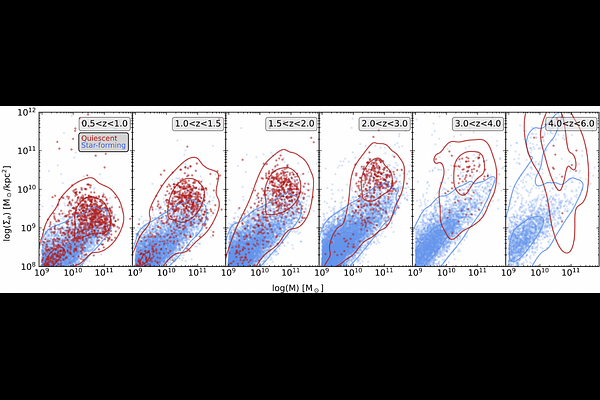DAWN JWST Archive: Morphology from profile fitting of over 340,000 galaxies in major fields

DAWN JWST Archive: Morphology from profile fitting of over 340,000 galaxies in major fields
Aurélien Genin, Marko Shuntov, Gabe Brammer, Natalie Allen, Kei Ito, Georgios Magdis, Jasleen Matharu, Pascal A. Oesch, Sune Toft, Francesco Valentino
AbstractTo better understand how galaxies assemble their structure and evolve over cosmic time, we present a new catalog of morphological measurements for over 340,000 sources spanning $0 < z < 12$, derived from deep JWST NIRCam imaging across four major extragalactic fields (CEERS, PRIMER-UDS, PRIMER-COSMOS, GOODS) compiled in the DAWN JWST Archive (DJA). We perform two-dimensional surface brightness fitting for all galaxies in a uniform, flux-limited sample. Each galaxy is modeled with both a S\'ersic profile and a two-component (bulge and disk) decomposition, yielding consistent structural parameters - including effective radius, S\'ersic index, axis ratio, and bulge-to-total ratio ($B/T$). To demonstrate the scientific application of our morphology catalogs, we combined these measurements with DJA photometric redshifts, physical parameters and rest-frame colors, and investigated the relation between total, bulge and disk sizes, S\'ersic index ($n_S$), star formation activity, and redshift. Bulge-dominated galaxies (high $n_S$ and $B/T$) predominantly occupy the quiescent region of the $UVJ$ diagram, while disk-dominated galaxies are mostly star-forming. A significant bimodality persists, with quiescent disks and compact, bulge-dominated star-forming galaxies observed out to $z > 3$. Quiescent galaxies also show significantly higher stellar mass surface densities, nearly an order of magnitude greater at $z \sim 4$ than at $z \sim 1$. Our results confirm a strong and evolving link between morphology and star formation activity, and support a scenario in which bulge growth and quenching are closely connected. This work is a highly valuable addition to the DJA, adding a morphological dimension to this rich dataset and thus enabling a wider scientific application.